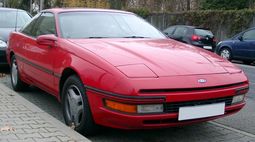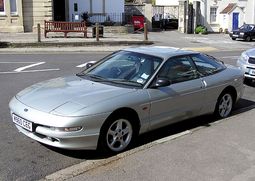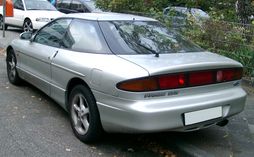The History Of FORD Probe

The Ford Probe was a coupe produced by Ford, introduced in 1989 to replace the Ford EXP as the company's sport compact car. The Probe was fully based on the Mazda G-platform using unique sheetmetal and interior. The instrument cluster and pop-up headlight mechanisms are borrowed from the FC RX-7. While it was sold worldwide as a sporty coupe, the Probe was intended to fill the market niche formerly occupied by the Capri in Europe, and although it was intended as the replacement to the Ford EXP, it was also considered a possible replacement for the Ford Mustang in the North American market as a direct competitor with the Acura Integra and the Toyota Celica. During that time, Ford's marketing team had deemed that a front-wheel drive platform (borrowed Mazda GD and GE platforms) would have lower costs for production, and also because the platform had been gaining popularity with the consumers. Mustang fans objected to the front-wheel drive configuration, Japanese engineering, and lack of a V8, so Ford began work on a new design for the Mustang instead.
Starting in the late 1970s, Ford and Ghia started exploring a series of futuristic designs under the "probe" series of concept cars. The Probe I, first shown in 1979, was a wedge-shaped design that incorporated a number of drag-reducing features like covered rear wheels and pop-up headlights. This was followed the next year by a much more conventional looking Probe II, whose hatchback styling is reminiscent of the Pony cars. 1981's Probe III was an advanced demonstrator with covered wheels, but its bodywork evolved into the more conventional Ford Sierra (or Merkur XR4Ti) and styling notes were used on the Ford Taurus. 1982's Probe IV was a more radical concept car with an extremely low Cd, and evolved into 1984's equally radical Probe V.
In the 1980s, a predicted increase in oil prices prompted Ford to give the Ford Mustang a major redesign. The new design would be based on a totally new platform introduced to Ford by Japanese car manufacturer and Ford partner Mazda. But when the new generation of the Ford Mustang neared its release date, oil prices dropped to an all time low and Ford Mustang buyers expressed their displeasure in the style of the proposed replacement. The car was eventually released, not as a Ford Mustang but as the Ford Probe.
The Ford Probe is a product of the joint Ford and Mazda venture called the AutoAlliance. It's unique body panels and interior were designed and manufactured in the AutoAlliance International Incorporated assembly plant located in Flat Rock, Michigan, the same plant that manufactured the Mazda MX-6 coupe and Mazda 626 sedan for the North American market.
The Ford Probe was introduced to the US market in 1989 and was nearly identical to the Mazda MX-6. Actually, the Ford Probe shares most of its mechanical parts with the Mazda MX-6 and 626. Both the Ford Probe and the Mazda MX-6 were based on the Mazda GD platform from 1988 to 1992, and on the GE platform from 1993 to 1997.
As it was initially planned to replace the successful and popular Ford Mustang, Ford expected the Ford Probe to be a success and boost the sales for the company. But the car fell short of Ford’s expectations. The style of the said coupe, while modern, was not universally accepted. It was neither affordable, making many buyers choose some other more-prestigious brand for the price they would pay for a Ford Probe. It was not able to match the success of the Ford Mustang and in fact never got near the expected sales figures, selling only 837,273 units in its eight year production run. In 1997, sales dropped to only 32,505 units, and it was finally discontinued.
The first generation Probe appeared in 1988 and lasted until 1992 in the United States. In some markets the model years were from 1987 to 1991. It was based on a series of futuristic concept cars of the early 1980s, the likes of which have been seen in films like Judge Dredd, Back to the Future Part II and Total Recall. It was a coupe based on the Mazda GD platform, and was powered by a 2.2 L SOHC I4 cylinder Mazda F2 engine. The base engine produced just 120 hp (82 kW), but a 145 hp (108 kW) with 190lb·ft (258N·m) of torque with the turbocharged version.
This generation was available in several trim levels, which differ depending on the market the vehicle was sold in. In the United States, the Probe was available in GL, LX, and GT trim levels:
GL was the "bare bones" model, offering the base 120hp (89kW)/ 130lb·ft (176N·m) F2 2.2 L engine and few options, but most Probes sold in the U.S. were equipped with air conditioning. LX added power windows, power locks, and power mirrors, as well as an optional manually operated moonroof; starting in 1990 the LX was available with the 3.0 L "Vulcan" V6, also used in the Ford Taurus, Ford Ranger, Ford Tempo, and Ford Aerostar. The Probe GT included all options from the LX, but also stepped up to the F2T 2.2 L turbocharged, intercooled engine, which put out 145hp (108kW) and 190lb·ft (258N·m) of torque delivering a significant performance boost. It also had 4 wheel disc brakes with ABS and 3 way adjustable suspension and a speed-sensitive variable-assist power steering (VAP). VAP provides sharp on-center feel and reassuring feedback as cornering forces increase.
The more energetic GT powerplant adds an IHI RHB5-VJ11 turbocharger and an intercooler to the intake tract, as well as a knock sensor and electronic boost control to the engine-control system. The entire arrangement is calibrated to provide strong midrange output; the maximum boost pressure rises to 9.3psi (0.64bar) in the vicinity of 3500 rpm, tapering down to 7.3psi (0.50bar) elsewhere. The results are 145hp (108kW) power peak at a relatively low 4300 rpm and 190lb·ft (258N·m) of torque at 6000 rpm.
The Probe GT's chassis and suspension system is based on a Mazda design, but its suspension tuning is the result of extensive Ford testing and calibration to achieve the optimized handling characteristics exclusive to the Probe. Both front and rear struts are nitrogen-gas pressurized, and the stabilizer bar sizes were optimized for hard cornering. The Probe GT also offers a special Automatic Adjusting Suspension, a computer-controlled system utilizing variable damping shocks that adjust to best accommodate acceleration, braking, and cornering forces. A sort of forerunner to active suspension control, the system permits three different shock damping modes-Soft, Normal-Auto and Sport. The Soft mode provides the smoothest ride, while the remaining two modes are used for higher-performance driving. In these modes the microprocessor monitors vehicle speed, acceleration, braking, and steering wheel angle, and automatically adjusts the shock absorbers for better handling while reverting to a comfortable ride on smooth roads. Above 50mph (80km/ h), the front shocks are automatically tightened to "firm" in Normal-Auto and to "extra-firm" in Sport to provide increased high speed stability.
The 1991 Probe was given a 4-star crash rating when subjected to collision tests. While the opposing subject often took severe damage to the point of requiring total loss, the Ford Probe sustained nothing but body damage.[citation needed]
An official picture was shown in 1991, though the second generation Ford Probe debut in December 1992 as a 1993 model in North America, while in other parts of the world it debut as a 1992 model. It was assembled by AutoAlliance International in Flat Rock, Michigan. Two trim levels were initially offered, GL and GT, each with two preferred equipment packages that were offered by Ford, 046A and 047A for the GL or base model, 050A and 051A for the GT model.
The GL or base model started at just over $13,000 USD and came standard with a 2.0 L I4 engine, performance instrument cluster with tachometer and full gauge compliment, and electronic AM/ FM stereo radio. The sportier GT model started at $15,504 USD and came standard with a 2.5 L V6 engine, low profile P225/ 50VR16 91V Goodyear VR50 Gatorback tires, 4-wheel disc brakes, unique front and rear fascias, fog lights, 5-spoke aluminum wheels, leather wrapped steering wheel, and driver seat power lumbar/ seat back side bolster adjustment. Both engines featured double overhead cam designs with the choice of a 5-speed manual transmission or a 4-speed automatic transmission.
Two automatic transmissions were available to the Ford Probe. At first both engines shared the same automatic transmission, the Ford F-4EAT transmission, but from 1994 onwards this changed. The V6 engine continued to use the 4EAT, but the 2.0 L I4 engine used a different automatic transmission, the Ford CD4E transmission. It was sourced by Ford, and manufactured at Ford's Batavia Transmission plant in Batavia, Ohio.
In 1994 there was a "Feature Model" Probe which included Wild Orchid exterior paint, unique floor mats that had "PROBE" embroidered into them, and black GT cloth bucket seats with unique purple inserts. Wild Orchid Probe Picture
A new SE (Sports Edition) trim level also debut in 1994 which included the GT front fascia (without fog lamps), GT body-color bodyside cladding, unique 15-inch (380mm) aluminum wheels, P205/ 55R15 BSW and Sport Edition "SE" nomenclature.
The rear spoiler was made standard on the 1996 Probe GTs. Previously it was a very popular dealer installed accessory.
In 1997 (the Probe's final year of production) a GTS trim level was offered. It had no more performance than the regular GT, but exterior modifications were distinct. Dual racing stripes available in either white or black started at the top edge of the front bumper and continued on to the back lip of the hatch, terminating just below the center light reflector on the rear bumper. Chrome wheels and a spoiler were also included in the package, as well as having a "blank" center reflector which lacked "GT" lettering that was characteristic to the Australian and European models which were available in either 16V and 24V versus "GT","SE",or base model in North America.
In Japan, the 2.5 L V6 was the higher performance KL-ZE. In Europe and America, the 2.5 L V6 was a lower performance KL-DE (often incorrectly referred to as the KL-03) and the 2.0 L was the FS. The primary difference of the Japanese version is that it produced 36hp (27kW) more power though higher compression pistons, aggressive camshafts, intake manifold and head. It also lacked an emissions control component called Exhaust gas recirculation that is required by law in North America and Europe.
Originally, the Probe was only supposed to be on a one-year hiatus, as there were plans to bring it back in 1999 based on the Mondeo chassis. However due to a rationalization of the coupe models the Probe design was released as the Ford Cougar in Europe and the Mercury Cougar in the USA, as the North American Probe was replaced by the Ford Escort ZX2.
This is an example of equipment and options available on the 1993 model year, Canadian market vehicle. Vehicles destined for other markets may have had additional and/ or deleted equipment from this listing. An example would be on the European market vehicle, a rear fog light was in place of one of the rear backup lamps in order to meet the United Nations Economic Commission for Europe (UNECE), Transport Division Vehicle Regulation 38, and some vehicles were manufactured for right hand drive configuration.
(Initial offerings for 1993 model year in Canada)
P = Package feature O = Optional feature S = Standard feature
(Initial offering, 1993 model year)
(Initial specifications for 1993 model year)
The Probe GT was Motor Trend magazine's Car of the Year for 1993. It also made Car and Driver magazine's Ten Best list for 1989, 1993, and 1994.
From Wikipedia, the free encyclopedia
More About FORD Probe




|